
Arbigland in the historical county of Kirkcudbrightshire, Dumfries and Galloway, Scotland, lies on the coast of the Solway Firth, to the south-east of Kirkbean. It is the birthplace of John Paul Jones, the United States' first well-known naval commander in the American Revolutionary War. There is a birthplace museum in the cottage where he was born, donated by the Blackett family to the John Paul Jones Museum Trust in 1997. The Arbigland Estate also has a number of seaside holiday cottages.

Clan Johnstone is a Border Reiver Scottish clan.
Johnstonebridge is a village in Dumfries and Galloway, Scotland.

Buchanan Castle is a ruined castle in Stirlingshire, Scotland, located 1 mile (1.6 km) west of the village of Drymen. The house was commissioned by The 4th Duke of Montrose and built in 1852-1858 as a home for the Montrose family, serving as such until 1925. It was built as a replacement for Buchanan Auld House, which is located 0.5 miles (0.80 km) to the northwest but was destroyed in a fire in 1852. The old house and surrounding lands had been the property of the Clan Buchanan but passed to the Clan Graham in the late 17th century. The roof of the building was removed in 1954 and the condition of the house has since deteriorated, but it remains the seat of the Clan Graham.

Dumfries House is a Palladian country house in Ayrshire, Scotland. It is located within a large estate, around two miles (3 km) west of Cumnock. Noted for being one of the few such houses with much of its original 18th-century furniture still present, including specially commissioned Thomas Chippendale pieces, the house and estate is now owned by The Prince's Foundation, a charity which maintains it as a visitor attraction and hospitality and wedding venue. Both the house and the gardens are listed as significant aspects of Scottish heritage.

Craigiehall is a late-17th-century country house, which until 2015 served as the Headquarters of the British Army in Scotland. It is located close to Cramond, around 9 km (5.6 mi) west of central Edinburgh, Scotland.
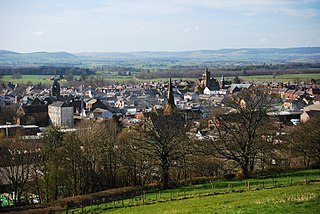
Lockerbie is a town in Dumfries and Galloway, south-western Scotland. It is about 120 km (75 mi) from Glasgow, and 25 km (16 mi) from the border with England. The 2001 Census recorded its population as 4,009. The town came to international attention in December 1988 when the wreckage of Pan Am Flight 103 crashed there following a terrorist bomb attack aboard the flight.

Cally Palace, formerly known as Cally House, is an 18th-century country house in the historical county of Kirkcudbrightshire in Dumfries and Galloway, south-west Scotland. The house is now a four star country house hotel and golf resort. It is located 1.2 kilometres (0.75 mi) south of Gatehouse of Fleet.
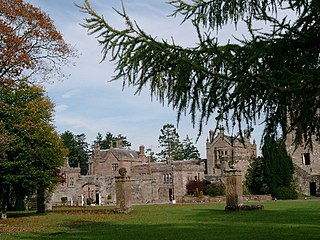
Hoddom Castle is a large tower house in Dumfries and Galloway, south Scotland. It is located by the River Annan, 4 kilometres (2.5 mi) south-west of Ecclefechan and the same distance north-west of Brydekirk in the parish of Cummertrees. The castle is protected as a category A listed building.
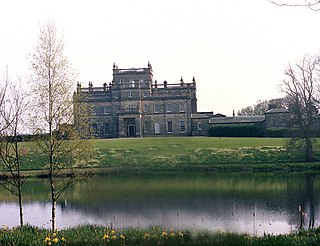
Kinmount House is a 19th-century country house in the parish of Cummertrees in the historic county of Dumfriesshire in Dumfries and Galloway region, Scotland. It is located 3+1⁄2 miles (5.6 km) west of Annan. The house was designed by Sir Robert Smirke for the 6th Marquess of Queensberry and completed in 1820. It is protected as a category A listed building, and the grounds are included on the Inventory of Gardens and Designed Landscapes in Scotland.

Yester House is an early 18th-century mansion near Gifford in East Lothian, Scotland. It was the home of the Hay family, later Marquesses of Tweeddale, from the 15th century until the late 1960s. Construction of the present house began in 1699, and continued well into the 18th century in a series of building phases. It is now protected as a category A listed building, and the grounds of the house are included in the Inventory of Gardens and Designed Landscapes in Scotland, the national listing of significant gardens.

Oxenfoord Castle is a country house in Midlothian, Scotland. It is located 1 kilometre (0.62 mi) north of Pathhead, Midlothian, and 6 kilometres (3.7 mi) south-east of Dalkeith, above the Tyne Water. Originally a 16th-century tower house, the present castle is largely the result of major rebuilding in 1782, to designs by the architect Robert Adam. Oxenfoord was the seat of the Earl of Stair from 1840, and remains in private ownership. It is protected as a category A listed building, while the grounds are included in the Inventory of Gardens and Designed Landscapes in Scotland.

Monreith House is a category A listed Georgian mansion located 1.5 kilometres (0.93 mi) east of the village of Port William in Mochrum parish in the historical county of Wigtownshire in Dumfries and Galloway, Scotland. The classical-style house was designed by Alexander Stevens in 1791, for Sir William Maxwell, 4th Baronet. The new house replaced the now-ruined Myrton Castle on the estate which was partially dismantled to provide stone for the house. The grounds of the house are included in the Inventory of Gardens and Designed Landscapes in Scotland, the national listing of significant gardens, and are classed as "outstanding" in five out of six categories.
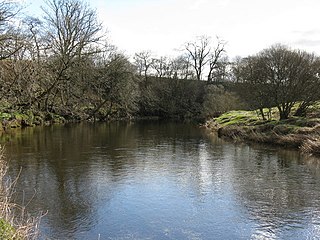
The Kinnel Water is a river in the Scottish council area of Dumfries and Galloway, in the shire of Dumfriesshire.

Anwoth Parish Church was built in 1826 to serve the parish of Anwoth in Dumfries and Galloway, Scotland. Designed by Walter Newall, it replaced Anwoth Old Church, which had been the parish church since it was built in 1626 and was partially demolished at the same time as the new church was built.
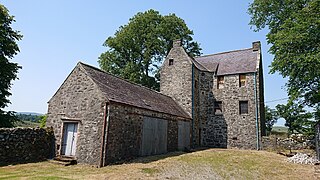
Earlstoun Castle, sometimes spelled Earlston Castle, is a derelict tower house near St John's Town of Dalry in Dumfries and Galloway, Scotland. Built in the late sixteenth century, it was home to members of the Gordon family, including William Gordon of Earlston who was killed at the battle of Bothwell Bridge. It is unusual for a tower house of its age for its lack of defensive arrangements: it has no gun loops, its roof is without a parapet or corner turrets, and it lies in open ground without natural defences.

Annan Town Hall is a municipal building in the High Street in Annan, Dumfries and Galloway, Scotland. The structure, which accommodates the local library and is also used as a venue for the provision of local services, is a Category B listed building.

Lochmaben Town Hall is a municipal building in the High Street in Lochmaben, Dumfries and Galloway, Scotland. The structure, which accommodates a library and a local customer services point, is a Category A listed building.

Langholm Town Hall is a municipal building in the High Street in Langholm, Dumfries and Galloway, Scotland. The structure, which is used as a community events venue, is a Category B listed building.

Sanquhar Tolbooth is a municipal building in the High Street in Sanquhar, Dumfries and Galloway, Scotland. The structure, which accommodates a local history museum, is a Category A listed building.




















